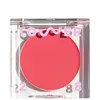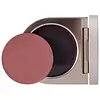What's inside
What's inside
 Key Ingredients
Key Ingredients

 Benefits
Benefits

 Concerns
Concerns

 Ingredients Side-by-side
Ingredients Side-by-side

Hydrogenated Polyisobutene
EmollientZea Mays Starch
AbsorbentRicinus Communis Seed Oil
MaskingPolyhydroxystearic Acid
EmulsifyingHelianthus Annuus Seed Wax
Skin ConditioningDiisostearyl Malate
EmollientTriisostearyl Citrate
EmollientMicrocrystalline Wax
Emulsion StabilisingJojoba Esters
EmollientButyrospermum Parkii Butter
Skin ConditioningOrbignya Oleifera Seed Oil
EmollientOryza Sativa Bran Extract
Skin ConditioningHelianthus Annuus Extract
EmollientRosmarinus Officinalis Leaf Extract
AntimicrobialCamellia Sinensis Leaf Extract
AntimicrobialChamomilla Recutita Flower Extract
MaskingAloe Barbadensis Leaf Extract
EmollientCarthamus Tinctorius Seed Oil
MaskingAcacia Decurrens Flower Wax
EmollientPersea Gratissima Oil
Skin ConditioningRosa Canina Fruit Oil
EmollientGlycine Soja Oil
EmollientTocopherol
AntioxidantPolyglycerin-3
HumectantCaprylyl Glycol
EmollientEthylhexylglycerin
Skin ConditioningCI 77491
Cosmetic ColorantCI 77492
Cosmetic ColorantCI 77499
Cosmetic ColorantCI 15850
Cosmetic ColorantCI 45380
Cosmetic ColorantCI 73360
Cosmetic ColorantCI 77891
Cosmetic ColorantHydrogenated Polyisobutene, Zea Mays Starch, Ricinus Communis Seed Oil, Polyhydroxystearic Acid, Helianthus Annuus Seed Wax, Diisostearyl Malate, Triisostearyl Citrate, Microcrystalline Wax, Jojoba Esters, Butyrospermum Parkii Butter, Orbignya Oleifera Seed Oil, Oryza Sativa Bran Extract, Helianthus Annuus Extract, Rosmarinus Officinalis Leaf Extract, Camellia Sinensis Leaf Extract, Chamomilla Recutita Flower Extract, Aloe Barbadensis Leaf Extract, Carthamus Tinctorius Seed Oil, Acacia Decurrens Flower Wax, Persea Gratissima Oil, Rosa Canina Fruit Oil, Glycine Soja Oil, Tocopherol, Polyglycerin-3, Caprylyl Glycol, Ethylhexylglycerin, CI 77491, CI 77492, CI 77499, CI 15850, CI 45380, CI 73360, CI 77891
Ricinus Communis Seed Oil
MaskingPentaerythrityl Tetraisostearate
EmollientCaprylic/Capric Triglyceride
MaskingCopernicia Cerifera Wax
Oryza Sativa Bran Wax
Skin ConditioningHydrogenated Vegetable Oil
EmollientSynthetic Fluorphlogopite
Silica
AbrasiveIsononyl Isononanoate
EmollientLauroyl Lysine
Skin ConditioningEuphorbia Cerifera Wax
Squalane
EmollientSodium Hyaluronate
HumectantCeramide Ng
Skin ConditioningRosmarinus Officinalis Leaf Extract
AntimicrobialHelianthus Annuus Seed Oil
EmollientTocopherol
AntioxidantCaprylyl Glycol
EmollientHydrogenated Castor Oil
EmollientSorbitan Tristearate
Emulsifying1,2-Hexanediol
Skin ConditioningTropolone
Skin ConditioningAluminum Hydroxide
EmollientTin Oxide
AbrasiveMica
Cosmetic ColorantCI 77891
Cosmetic ColorantIron Oxides
CI 15850
Cosmetic ColorantCI 45410
Cosmetic ColorantRicinus Communis Seed Oil, Pentaerythrityl Tetraisostearate, Caprylic/Capric Triglyceride, Copernicia Cerifera Wax, Oryza Sativa Bran Wax, Hydrogenated Vegetable Oil, Synthetic Fluorphlogopite, Silica, Isononyl Isononanoate, Lauroyl Lysine, Euphorbia Cerifera Wax, Squalane, Sodium Hyaluronate, Ceramide Ng, Rosmarinus Officinalis Leaf Extract, Helianthus Annuus Seed Oil, Tocopherol, Caprylyl Glycol, Hydrogenated Castor Oil, Sorbitan Tristearate, 1,2-Hexanediol, Tropolone, Aluminum Hydroxide, Tin Oxide, Mica, CI 77891, Iron Oxides, CI 15850, CI 45410
 Reviews
Reviews

Alternatives
Ingredients Explained
These ingredients are found in both products.
Ingredients higher up in an ingredient list are typically present in a larger amount.
Caprylyl Glycol is a humectant and emollient, meaning it attracts and preserves moisture.
It is a common ingredient in many products, especially those designed to hydrate skin. The primary benefits are retaining moisture, skin softening, and promoting a healthy skin barrier.
Though Caprylyl Glycol is an alcohol derived from fatty acids, it is not the kind that can dry out skin.
This ingredient is also used as a preservative to extend the life of products. It has slight antimicrobial properties.
Learn more about Caprylyl GlycolCi 15850 is the pigment color red. It is an azo dye and created synthetically.
Azo dyes need to be thoroughly purified before use. This allows them to be more stable and longer-lasting.
This ingredient is common in foundations, lipsticks, and blushes. This color is described as brown/orangey red.
It has many secondary names such as Red 6 and Red 7. According to a manufacturer, Red 6 usually contains aluminum.
Learn more about CI 15850Ci 77891 is a white pigment from Titanium dioxide. It is naturally found in minerals such as rutile and ilmenite.
It's main function is to add a white color to cosmetics. It can also be mixed with other colors to create different shades.
Ci 77891 is commonly found in sunscreens due to its ability to block UV rays.
Learn more about CI 77891Ricinus Communis Seed Oil is the INCI name for castor oil.
Castor Oil helps moisturize the skin. It is rich in a fatty acid called ricinoleic acid. This fatty acid helps prevent moisture loss on the skin. This helps keep your skin soft and hydrated. Ricinoleic acid also has anti-inflammatory and pain reducing properties.
Besides hydrating the skin, castor oil is also used to hydrate hair. By keeping the hair shaft moisturized, breakage is decreased. More studies are needed to show castor oil's effective on stimulating hair growth.
Castor oil is created by cold-pressing castor seeds and then purifying the oil with heat. It was used in Ancient Egypt as fuel in lamps and to help treat eye irritation.
The term 'fragrance' is not regulated in many countries. In many cases, it is up to the brand to define this term. For instance, many brands choose to label themselves as "fragrance-free" because they are not using synthetic fragrances. However, their products may still contain ingredients such as essential oils that are considered a fragrance.
Learn more about Ricinus Communis Seed OilRosmarinus Officinalis Leaf Extract comes from rosemary. Rosemary is native to the Mediterranean.
While Rosmarinus Officinalis Leaf Oil can be volatile due to its fragrant properties, the fragrance components are usually removed in the leaf extract.
Rosemary Leaf Extract contains many antioxidants such as rosmarinic acid and caffeic acid. Rosemarinic acid, a compound found in rosemary leaf, has been found to help soothe skin conditions such as eczema and acne.
Learn more about Rosmarinus Officinalis Leaf ExtractTocopherol (also known as Vitamin E) is a common antioxidant used to help protect the skin from free-radicals and strengthen the skin barrier. It's also fat soluble - this means our skin is great at absorbing it.
Vitamin E also helps keep your natural skin lipids healthy. Your lipid skin barrier naturally consists of lipids, ceramides, and fatty acids. Vitamin E offers extra protection for your skin’s lipid barrier, keeping your skin healthy and nourished.
Another benefit is a bit of UV protection. Vitamin E helps reduce the damage caused by UVB rays. (It should not replace your sunscreen). Combining it with Vitamin C can decrease sunburned cells and hyperpigmentation after UV exposure.
You might have noticed Vitamin E + C often paired together. This is because it is great at stabilizing Vitamin C. Using the two together helps increase the effectiveness of both ingredients.
There are often claims that Vitamin E can reduce/prevent scarring, but these claims haven't been confirmed by scientific research.
Learn more about Tocopherol